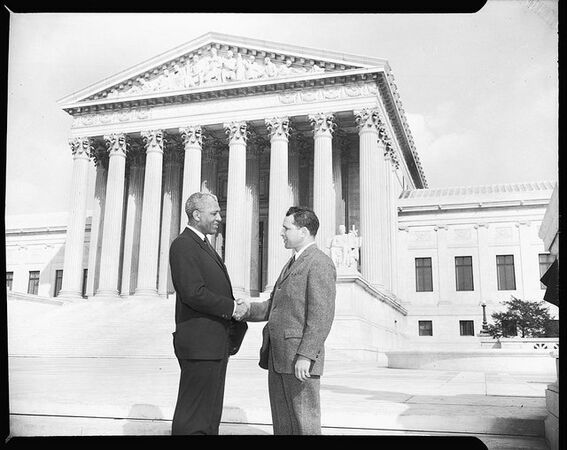Garland v. VanDerStok
 | |
| Garland v. VanDerStok | |
| Docket number: 23-852 | |
| Term: 2024 | |
| Court: United States Supreme Court | |
| Important dates | |
| Argued: October 8, 2024 | |
| Court membership | |
| Chief Justice John Roberts • Clarence Thomas • Samuel Alito • Sonia Sotomayor • Elena Kagan • Neil Gorsuch • Brett Kavanaugh • Amy Coney Barrett • Ketanji Brown Jackson | |
Garland v. VanDerStok is a case challenging the U.S. Bureau of Alcohol, Tobacco, Firearms and Explosives’ (ATF) authority to issue a rule regulating firearm parts kits, which the agency refers to as ghost guns. Click here to learn more about the case's background.
The case was argued before the Supreme Court of the United States on October 8, 2024, during the court's October 2024-2025 term.[1]
2. Whether "a partially complete, disassembled, or nonfunctional frame or receiver" that is "designed to or may readily be completed, assembled, restored, or otherwise converted to function as a frame or receiver," 27 C.F.R. 478.12(c), is a "frame or receiver" regulated by the Act."[2]
The case came on a writ of certiorari to the United States Court of Appeals for the Fifth Circuit. To review the lower court's opinion, click here.
Why it matters: The case could clarify the extent of the ATF’s statutory authority under the Gun Control Act of 1968. The case also has the potential to nullify the agency’s regulations on firearm parts kits.
Background
| Administrative State |
|---|
| Five Pillars of the Administrative State |
| • Judicial deference • Nondelegation • Executive control • Procedural rights • Agency dynamics |
| Click here for more coverage of the administrative state on Ballotpedia |
Case summary
The following are the parties to this case:[3]
- Petitioner: Merrick B. Garland, United States Attorney General, et al.
- Legal counsel: Elizabeth B. Prelogar, United States Solicitor General
- Respondent: Jennifer VanDerStok, et al.
- Legal counsel: Charles Randall Flores (Flores Law PLLC), David H. Thompson (Cooper & Kirk, PLLC)
The following summary of the case was published by Oyez, a free law project from Cornell’s Legal Information Institute, Justia, and the Chicago-Kent College of Law:[4]
| “ |
ATF, created in 1972, is responsible for regulating firearms under the Gun Control Act of 1968 (GCA). The GCA requires federal firearms licensees (FFLs) to conduct background checks, record firearm transfers, and serialize firearms when selling or transferring them. The GCA’s regulation of firearms is based on the definition of “firearm,” which includes the “frame or receiver.” However, ATF’s 1978 definition of “frame or receiver” became outdated due to changes in modern firearm design, such as the AR-15 and Glock pistols. Furthermore, the rise of privately made firearms (PMFs) or “ghost guns” posed challenges to law enforcement because they were not regulated under the GCA and did not require serialization. In response, ATF issued a Final Rule in 2022, updating the definitions of “frame,” “receiver,” and “firearm” to better capture modern firearm designs and regulate PMFs. The Final Rule took effect on August 24, 2022. The respondents in this case challenged the Final Rule’s redefinition of “frame or receiver” and “firearm,” arguing that it exceeded ATF’s congressionally mandated authority. The district court granted summary judgment to the plaintiffs and vacated the Final Rule in its entirety. The U.S. Court of Appeals for the Fifth Circuit affirmed the district court’s determination that the two provisions exceeded ATF’s statutory authority.[5] |
” |
To learn more about this case, see the following:
Timeline
The following timeline details key events in this case:
- October 8, 2024: The U.S. Supreme Court heard oral argument.
- April 22, 2024: The U.S. Supreme Court agreed to hear the case.
- February 7, 2024: U.S. Attorney General Merrick B. Garland, et al. appealed to the U.S. Supreme Court.
- November 9, 2023: The United States Court of Appeals for the Fifth Circuit affirmed the United States District Court for the Northern District of Texas' ruling in part and vacated the ruling in part, and remanded the case for further proceedings.[6]
Questions presented
The petitioner presented the following questions to the court:[2]
Questions presented:
|
Oral argument
The U.S. Supreme Court heard oral argument on October 8, 2024.
Audio
Audio of oral argument:[7]
Transcript
Transcript of oral argument:[8]
Outcome
The case is pending adjudication before the U.S. Supreme Court.
October term 2024-2025
The Supreme Court began hearing cases for the term on October 7, 2024. The court's yearly term begins on the first Monday in October and lasts until the first Monday in October the following year. The court generally releases the majority of its decisions in mid-June.[9]
See also
External links
- Search Google News for this topic
- U.S. Supreme Court docket file - Garland v. VanDerStok (petitions, motions, briefs, opinions, and attorneys)
- SCOTUSblog case file for Garland v. VanDerStok
Footnotes
- ↑ SCOTUSblog, "Garland v. VanDerStok," accessed April 25, 2024
- ↑ 2.0 2.1 U.S. Supreme Court, "23-852 GARLAND V. VANDERSTOK QP REPORT," April 22, 2024
- ↑ Supreme Court of the United States, "No. 23-852," accessed August 7, 2024
- ↑ Oyez, "Garland v. VanDerStok," accessed August 7, 2024
- ↑ 5.0 5.1 Note: This text is quoted verbatim from the original source. Any inconsistencies are attributable to the original source.
- ↑ U.S. Court of Appeals for the 5th Circuit, VanDerStok v. Garland, decided November 9, 2023
- ↑ Supreme Court of the United States, "Oral Argument - Audio," argued October 8, 2024
- ↑ Supreme Court of the United States, "Oral Argument - Transcript," argued October 8, 2024
- ↑ SupremeCourt.gov, "The Supreme Court at Work: The Term and Caseload," accessed January 24, 2022
| ||||||||||||||||||||||||||||
| |||||||||||
| |||||||||||




